Sharlyn J. Lauby's Blog, page 35
August 6, 2023
Bookmark This! New Labor Law Posters Edition – hr bartender

Estimated reading time: 3 minutes
I recently published an article about new Fair Labor Standards Act (FLSA) labor law posters in response to President Biden signing the Consolidated Appropriations Act of 2023. In the article, I mentioned that there have been three labor law poster updates in the past 12 months. I didn’t get a chance to elaborate in the original article, so I wanted to offer some additional details today.
Here are the three pieces of legislation that prompted labor law poster changes.
Pregnant Workers Fairness Act (PWFA)
This is the most recent update in June 2023. The PWFA requires covered employers to provide reasonable accommodations to a qualified worker’s known limitations related to pregnancy, childbirth, or related medical conditions, unless the accommodation will cause the employer an undue hardship. An undue hardship is defined as causing significant difficulty or expense. Examples of possible accommodations include being able to sit, drink water, work flexible hours, and additional bathroom breaks.
Providing Urgent Maternal Protections for Nursing Mothers (PUMP) Act
This law went into effect in April 2023. Under the FLSA, covered employers must provide reasonable break time for an employee to express breast milk, as needed, for their nursing child for one year after the child’s birth. In addition, employees are entitled to a place to pump at work, other than a bathroom, that is shielded from view and free from intrusion. This applies to exempt and non-exempt employees.
The Equal Employment Opportunity Commission (EEOC) is responsible for investigating charges of discrimination against employers who are covered by federal anti-discrimination laws. Most employers with at least 15 employees are covered under EEOC laws. In October 2022, they issued a new “Know Your Rights” poster and covered employers are required to display the new poster at their work site.
If your organization hasn’t already done so, now is the time to make sure all your labor law posters are in compliance. This could also be a good time to think about signing up for a labor law poster service that provides updated posters at no additional cost whenever there’s a change in the law.
HR professionals have a long list of things to do – recruiting, training, benefits administration, and more. Compliance is one of those things. But when you can partner with someone who can do the work – and at a reasonable price – it only makes sense. I’m reminded of the phrase, “Just because you can doesn’t mean you should.” Can I research all the federal, state, and local labor law changes? Yes, I can. Is that the best use of my time? Hmmm…not really.
Labor law posters are important. Not only do they provide valuable information, but they show employees that the company cares about doing the right thing. Make sure your posters are compliant.
Image captured by Sharlyn Lauby while exploring the streets of Gainesville, FL
The post Bookmark This! New Labor Law Posters Edition – hr bartender appeared first on hr bartender.
August 3, 2023
HR Involvement in Office Drama – Ask HR Bartender

Estimated reading time: 3 minutes
As a HR professionals, we often hear workplace drama stories. And sadly, sometimes we find ourselves in the middle of the drama. That’s what today’s reader note is all about.
Hello. I’m the sole HR person at a small company. The owner is female, and her husband is vice president. An employee recently received driving while intoxicated (DUI) charge and entered voluntarily a 30-day rehab program. While in employee was in rehab, the owner of the company realized there was something going on between her husband, the employee’ manager, and the employee. I was aware of this, and the owner took a leave of absence, without explanation.
The employee returned recently and confided to me that she felt the company was going to fire her because she was having “two-hour lunches” with the vice president. There is a lot more to this story and I feel I have been put in the middle with the owner not knowing I know and the employee not wanting me to get involved.
I would like to share the entire scenario and discuss what my obligation is. I feel I could be targeted by the owner and husband/vice president if they find out that I’m aware of the situation.
Let me start this by saying that I’m not a lawyer and don’t pretend to be one. There’s a lot to unpack in this story and the reader even tells us that we don’t know everything. So, there’s no way for us to give a detailed response. But I do want to share some articles that might be helpful in trying to decide next steps.
A few years ago, we answered a reader note about an employee having an affair with the boss. Our friend and employment attorney Kate Bischoff talks about HR’s obligations in investigations. Both the company and HR can be at risk.
This reader mentions that they’re not sure the company knows that they are aware of the situation with the employee and vice president, which might be true. However, regardless of whether HR knows, it’s possible other employees can see what’s going on. That can have an impact on the workplace. Especially if they feel that HR should know and isn’t doing anything to stop it. We answered a reader question about when “HR fails to investigate an incident” a few years ago. It’s still a good reminder about the role HR plays in helping employees feel safe from mistreatment.
One of the things that stood out for me in this reader note is the size of the organization. Working at a small company has its advantages and disadvantages. As a HR professional, we’re often very close to senior leadership – which is great. But we also want to be seen as trustworthy and able to maintain confidentiality. If there are concerns about how HR is being perceived, a person needs to think about whether they can be effective in their role.
Lastly, I can’t tell someone to confront company leadership. That’s a decision this reader needs to make for themself. But to wrap up, I want to share two more articles:
Companies: When to Call a Labor and Employment Lawyer
Employees: When Should You Lawyer Up
Depending on your situation, HR professionals might be the ones calling on behalf of the organization OR calling on their own. I wish I could say that HR never gets dragged into the office drama, but sometimes it happens through no fault of our own. HR professionals need to do their homework and figure out the best way to respond – for themselves and the organization.
Image captured by Sharlyn Lauby while exploring the streets of Las Vegas, NV
The post HR Involvement in Office Drama – Ask HR Bartender appeared first on hr bartender.
August 1, 2023
Organizations Need to Proactively Monitor the Employee Experience
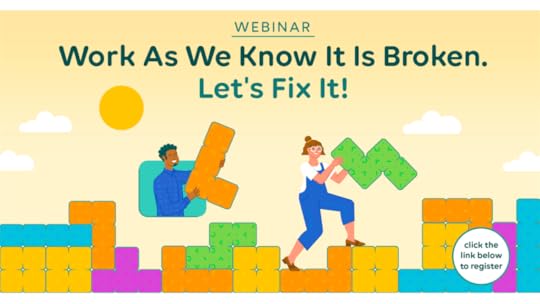
Estimated reading time: 6 minutes
(Editor’s Note: Today’s article is brought to you by our friends at UKG – Ultimate Kronos Group , a leading provider of HR, payroll, and workforce management solutions. . Congrats to UKG! Enjoy the article!)
The key word in today’s title is proactively. Organizations need to proactively monitor the employee experience. Many organizations address employee concerns by updating policies, procedures, and programs. Don’t get me wrong . . . that’s to be expected.
But they often do it as a reaction to something – like an employee complaint. Wouldn’t it be great if we didn’t wait for someone to complain? Or watch while a little concern becomes a major challenge.
When organizations wait until employee morale is poor or turnover is high to ask, “What’s happening here? Let’s fix it.”, then the result is that the organization uses far more resources taking a reactive approach. We all know that rebuilding trust and engagement is expensive. And we also know that turnover is expensive.
Ideally, we need to find a way to monitor the employee experience so we can address issues early – when they’re small. Because fixing a small issue early is less expensive. And more importantly, it sends the message to employees that the company will do something about employee concerns if you talk about it.
The way to do that is by managing and monitoring employee expectations. When employees share their work experiences, they’re comparing it to their expectations. No different than when customers share feedback. So, using employee expectations to understand the employee experience only makes sense. There are several activities that are ideal for managing and monitoring the employee experience. The good news is many of these activities are already in place.
Onboarding check-ins. These can be done in-person or online. By HR or managers. The goal is to find out from new hires how things are going. And if something isn’t the way the new hire expected, the company can address it. Even if it’s to educate the employee that what they think “isn’t fine” is in actuality “just fine”. For instance, maybe there’s a policy the employee isn’t aware of.
One-on-one meetings. These meetings are typically conducted between the manager and the employee. They are designed to talk about what’s happening in the workplace, performance, and solicit feedback. Not only should managers be trained on how to conduct one-on-one meetings, but employees should be as well.
Skip-level interviews. The idea of a skip-level interview is the employee meets with their manager’s boss. Sometimes this happens one-on-one and sometimes in a group (aka the “coffee with the VP” type meeting). Skip-level interviews give employees the chance to share feedback and hear views from a different voice in the organization. I’m not implying that during a skip-level interview the conversation is different – although it could be. Rather, that skip-level interviews might share the same information using a different perspective. And that could be helpful to both the employee and the executive.
Engagement surveys. Engagement surveys are still a great medium for collecting information from large groups of employees. That being said, it is important to design a good survey to collect good data. Survey data can be used during one-on-ones and skip-level meetings to dig deeper and get more information directly from employees.
Stay interviews. The concept of a stay interview is to find out from employees what makes them stay with the company. This can be a great way to understand what employees like – and be aware when making decisions. For example, if employees say that one of the reasons they stay with the company is the health insurance benefit, then the company should know that before changing the health insurance … and risking employees being upset.
We can take the information from these activities, analyze it, and proactively address areas that could grow into significant challenges. There’s one other thing we need to do. And that’s set good expectations during these activities. And by good, I mean realistic.
It’s not fair to the employee, manager, or company to have check-ins, meetings, and surveys then not do anything with the information received. Organizations should communicate the purpose of the activity and what will be done with the information. And they should follow-up with employees if a suggestion isn’t something the organization can address immediately.
True story. I remember many years ago getting back some engagement survey results where employees in one department talked about not having the tools to do their job. They said their department manager wasn’t supportive. They said it wasn’t fair that department leadership was impacting their work performance … and ultimately their pay increase. So, we started meeting with employees about the survey results and asked for feedback. Long story short … we discovered that the employees needed a mop. Yes, one mop. I’ll let you do an internet search for the cost of one mop. Frankly, it was embarrassing that this had been escalated to the employee engagement survey. When we asked why they didn’t tell us sooner, they said because they didn’t know how.
I’m sharing this story because it’s an example of how organizations need to understand that employee expectations connect to the employee experience. It shows the importance of setting expectations and getting regular feedback. And it shows how a little thing – like a mop – can translate into a big thing – like unsupportive leadership.
The other takeaway from this story is that even when we think it’s obvious and that everyone should know where to go and who to talk to. Employees might need a bit of a refresher – especially if they’ve been working remotely. It’s also possible the organization has updated a few policies, procedures, and programs over the past few years.

Some readers might be saying, “I get it. But this is a big task.” And you’re right. It is. BUT organizations can break down these activities into more manageable parts. Make a plan and work the plan.
The place to start is a gap analysis. Find out where the organization stands right now. That means identifying current employee expectations and reaching consensus on how to manage and monitor expectations moving forward. The results of the gap analysis can become your plan to close the gap, monitor progress, and measure future success.
Our friends at UKG are hosting a webinar on Tuesday, August 29, 2023, at 2p Eastern discussing the topic of Work as We Know It is Broken: Here’s What We Can Do About It. Michael Puck, UKG HR innovation fellow, will introduce the Employee Expectation Experience (Triple E) Gap Analysis. It’s a FREE easy-to-use, research-based online tool that enables organizations to self-assess in just minutes how well they’re positioned to address the expectations of today’s employees. And as always, if you’re already booked that day, sign up anyway to get the recording (and free access to the Triple E tool).
I want to believe we all agree that organizations need to have a pulse on what’s happening in the workplace. The process of doing so is a never-ending task. Because expectations change all the time – company expectations, customer expectations, and employee expectations.
That’s why using a gap analysis to set a baseline then regularly utilizing the feedback tools we discussed here allows the organization to proactively monitor the employee experience.
The post Organizations Need to Proactively Monitor the Employee Experience appeared first on hr bartender.
July 30, 2023
Should Managers Be Coaches Or Is There a Better Option
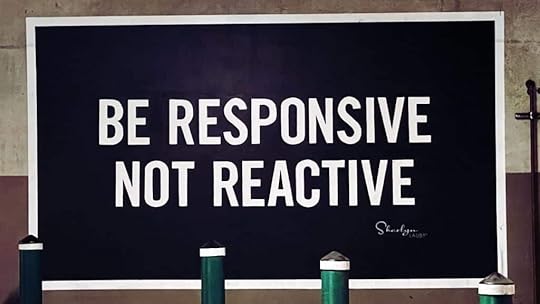
Estimated reading time: 3 minutes
There was an article recently on Fortune titled, “A company replaced all of its managers with coaches. Employees became 20% more productive–and much happier.” It’s an interesting read worth checking out and maybe not for the reason you might think.
For as long as I can remember, we’ve said that managers need to be coaches. They need to coach employees to maintain morale. Managers should coach employees to achieve improved performance. The Fortune article made me pause and wonder if that’s still the case. What was a little difficult to glean from the article was:
Did the company fire all their managers and replace them with coaches who can manage? Or,Did they just tell their managers to focus on managing and hire coaches to focus on coaching?Let’s look at the first question. If the organization fired all their current managers and replaced them with coaches who can manage, then why didn’t the company just provide coaching skills training to their management team? There are lots of consultants who provide this type of training. The company could have reached out to a coaching organization like the International Coaching Federation and signed up the management team to become certified coaches.
Say the cost of turnover is approximately one year’s salary. Then let’s say it could cost the company $50,000 to replace a single manager. But the cost of a coaching certification is $10,000. So, the organization spent $50,000 to save $10,000? That just doesn’t make sense.
Unless of course, the managers that were being replaced lacked some other skills. Then the company really isn’t getting rid of managers because they lack coaching skills. They’re getting rid of managers because they lack a whole bunch of skills. Which of course, raises the original question – why do the managers lack skills? Shouldn’t the company have been training and developing them all along?
That leads us to the second question. What if the organization said, “Asking managers to manage and be coaches is too much. Let’s hire some coaches to supplement what the manager is doing.” Remember the functions of management include planning, organizing, staffing, leading, and controlling. It is very possible that managers have too much on their plate.
And to do employee coaching well, the organization should consider having dedicated coaches. So, the company really didn’t “replace” their managers. What they did was add a coaching team to the organization. Honestly, that could make a lot of sense.
I remember touring the Zappos offices years ago and hearing that they offered coaching as an employee benefit. They had coaches come in during the workday. Employees could sign up to meet with a coach. And the coach would help the employee accomplish their goals – whatever those goals might be. Because that’s what coaches do. They help employees accomplish their goals.
While the Fortune article title was a bit clickbaity – or a lot clickbaity – it did make me pause and ask myself, “Are we expecting too much from managers?” “Would it make sense to have a coaching team?” I could see the entire company benefitting from a coaching team – including managers. Organizations could start with an external consultant – like Zappos did – and if it delivers results, consider an in-house team. This might be a perfect project for the company’s HR Lab.
Coaching is an important activity. It helps us improve our performance, which benefits the bottom-line. Maybe it’s time to view coaching as a value add to the management team.
Image captured by Sharlyn Lauby while exploring the streets of Gainesville, FL
The post Should Managers Be Coaches Or Is There a Better Option appeared first on hr bartender.
July 27, 2023
Work Is a Contributor to Wellbeing – hr bartender

Estimated reading time: 3 minutes
If you haven’t seen it, the American Psychological Association (APA) released the “2023 Work in America Survey”. And no surprise, it says that work is a contributor to our overall wellbeing. Here are a few highlights:
92% of workers said it’s important for them to work for an organization that values their wellbeing92% said it’s important for them to work for an organization that supports mental health95% said it’s important for them to feel respected at work95% said it’s important for them to work for an organization that respects the boundaries between work and non-workI’m going to get a little basic here. Let’s think about our day having three parts – work, non-work, and sleep. That means we spend approximately one-third of our time at work. So, to think that someplace where we spend that much time doesn’t impact us … well, that just seems out of touch.
Yet, there are plenty of people (and organizations) who haven’t adopted this mindset. Because if this was mainstream thinking then the American Psychological Association probably wouldn’t commission a study about it.
What I thought was really helpful about the APA study were the suggestions on how to support workplace wellbeing. The list included offering an employee assistance program (EAP), mental health benefits, flexible scheduling, and meeting-free workdays. But I wanted to add something to this list of suggestions.
Talk to your employees. Find out what they want. Ultimately, the organization wants to implement programs that employees will like and use. The suggestions from the APA are great conversation starters. Employees might not initially have definite ideas and using the APA suggestions can gauge initial reaction.
Create a test run. Organization might want to consider taking the top 2-3 suggestions that employees like and do them on a trial basis. Then get feedback before implementing. This allows the organization to do something to help workplace wellbeing and get employee feedback at the same time.
Regularly monitor and update. One of the biggest mistakes I see organizations make is that they implement programs and never revise them to reflect the times. The business (and non-business) world changes all the time. I know change is hard but it’s also necessary. So be prepared to review and revise programs as needed.
I’m sure we’re reading all the same articles about companies telling employees they need to spend more time onsite. Make the onsite work environment a place where employees can do the work and maintain their wellbeing. This doesn’t mean that there won’t be tough days. But if the number of tough days outnumbers the rest, then organizations need to ask themselves some questions.
Employees aren’t afraid of hard work. But they want to work someplace that acknowledges that work and puts programs in place to help when things do get tough.
Image captured by Sharlyn Lauby while exploring the streets of Fort Lauderdale, FL
The post Work Is a Contributor to Wellbeing – hr bartender appeared first on hr bartender.
July 25, 2023
NEW Fair Labor Standards Act (FLSA) Labor Law Posters

(Editor’s Note: Today’s article is brought to you by our friends at Poster Guard® Poster Compliance Service, a division of HRdirect and the leading labor law poster service that gets your business up to date with all required federal, state, and local labor law postings, and then keeps it that way — for an entire year. Enjoy the article!)
Just in case you missed it, President Biden signed the Consolidated Appropriations Act of 2023 on December 29, 2022. The Act has several components including:
Pregnant Workers Fairness Act (PWFA)Telehealth benefitsSetting Every Community Up for Retirement Enhancement (SECURE) 2.0 ActProviding Urgent Maternal Protections for Nursing Mothers (PUMP) ActThere’s a nice overview on the Society for Human Resource Management (SHRM) website “How does the Consolidated Appropriations Act of 2023 affect employers?” It’s worth checking out.
Today, I want to focus on the last provision I mentioned – the PUMP Act. With this provision, organizations need to update their federal labor law posters.
What is the PUMP Act?Under the Fair Labor Standards Act (FLSA), all covered employers must provide reasonable break time for an employee to express breast milk, as needed, for their nursing child for one year after the child’s birth. In addition, employees are entitled to a place to pump at work, other than a bathroom, that is shielded from view and free from intrusion.
The prior legislation excluded exempt employees from coverage, but the PUMP Act rectifies that. Plus, nonexempt employees who are not completely relieved from duty must be paid for that time. For more information about the PUMP Act, check out this fact sheet from the U.S. Department of Labor – as well as this frequently asked questions (FAQ) page.
Okay, now that we’re up-to-date with the PUMP Act, let’s talk about what you need to do as an employer. Well, the first thing is to get in compliance by updating your labor law posters.
And just an important reminder. This is the third time in the past 12 months that employers are required to update their labor law posters. Yes, you read that right. Back in October of last year, changes to equal employment opportunity laws resulted in a new “Know Your Rights” poster. In April of this year, the FLSA was revised to reflect the PUMP Act, which is what we’re talking about today. And get ready for it … just last month, the Pregnant Workers Fairness Act (PWFA) went into effect.
Now that organizations are facing a second (or third) new workplace poster, it’s a great time to think about your overall compliance strategy. Employers can move from being reactive to proactive when it comes to employment compliance.
Take a proactive approach to labor law postersFor a moment, let’s step back from the immediate need of the new FLSA poster. Nationwide, there are literally thousands of government agencies that are responsible for hundreds of mandatory posters.According to our friends at Poster Guard, they monitor more than 22,000 federal, state, and local agencies. Think of all the hours it takes to track these changes and stay in compliance. I’m pretty confident that HR does not have time to do this. And if they did, is this how they want to spend their valuable time?
That’s why instead of doing all this work yourself, you can rely on Poster Guard Poster Compliance Service. With this service, you receive an up-to-date federal poster that includes the new EEO poster, the new FLSA poster, PLUS other mandatory federal labor law posters. The service also provides all the necessary state and local posters.
Poster Guard extends a 100% guarantee that all posters are compliant – or they’ll pay any fine due to improper posting content. But to me, the best part of the service is that for an entire 12 months, you get new posters every time a mandatory change occurs … automatically and at no additional cost.

I’ve said it before, and I’ll say it again: This is money well spent. As HR professionals, researching labor law poster changes isn’t a good use of our time. Especially when there are companies like Poster Guard with a dedicated team of experts who can do it for you – effectively and efficiently.
Not only does this free up HR’s time to focus on hiring, engaging, and retaining employees, but it sends a strong message that you prioritize compliance and value the rights of your employees. The last thing an organization wants is for employees to see outdated compliance posters. It sends the message that following the law isn’t important and might cause job candidates or employees to wonder, “What else isn’t the company keeping up with?”
So, if you haven’t already, order your new labor law posters now. And while you’re at it, think about how to maintain poster compliance moving forward. This is the perfect time to move from a reactive compliance strategy to a proactive one by signing up for a poster replacement service. It’s the best way to maintain year-round compliance, allow HR to attend to other issues, and demonstrate your care about upholding the law.
The post NEW Fair Labor Standards Act (FLSA) Labor Law Posters appeared first on hr bartender.
July 23, 2023
How to Evaluate Your Employee Value Proposition
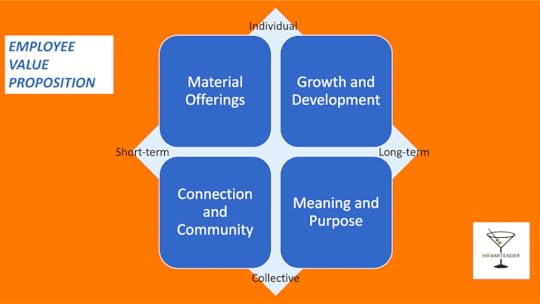
The employee value proposition (aka EVP) is the aggregate of things employees receive for working at the organization. Yes, it includes compensation and benefits, but it also includes more like training, wellbeing, etc. Every organization has an EVP. The question becomes what does it look like? For example, I found this graphic on the Lansing Board of Water & Light careers website.
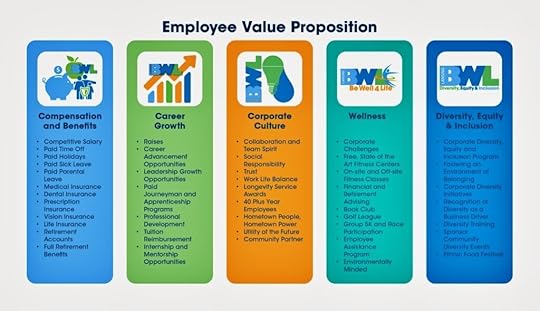
Here’s another one from Teare Executive Search:
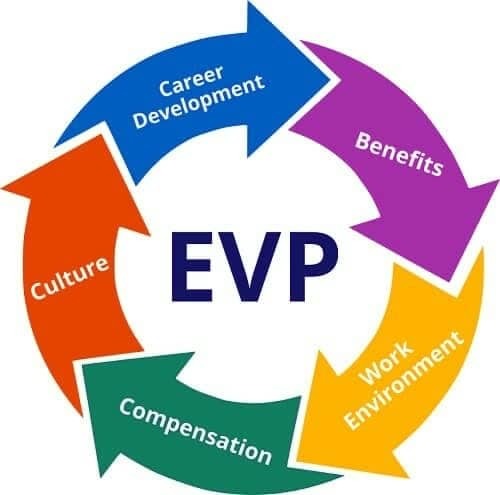
While the visualizations are different, both are great examples of what is found in an EVP. They emphasize that the EVP is part of an organization’s employment brand.
I recently came across a new visual for EVP that was very intriguing and wanted to share it with you. It was in the Harvard Business Review article “How to Win the Talent War”. It reflected the EVP in more of a quadrant format (see top image).
The top image above is my attempt to offer a visual. You can see a better version of the image in this LinkedIn post from Brian Heger, global head of strategic workforce planning and talent at Bristol-Myers Squibb.
The reason that I liked this model is because it has a short-term and long-term focus. So often when we’re talking with employees about the EVP, we’re focused on right now. We have an opening right now. The candidate needs a job right now. And we forget that we also need to think long-term about employee engagement and retention. I could see the EVP model being a nice way to talk about careers with candidates.
“As a new employee, you are eligible for ….”
“After you’ve been here for XX time, then you become eligible for …”
“Some of our longest tenured employees tell us they love this benefit …”
From an assessment perspective, organizations can look at the EVP model and ask themselves, “Do we offer both short- and long-term components?”
In addition, companies can also make sure that they offer something in each of the four areas: material offerings, growth and development, connection and community, and meaning and purpose. I’ve always said that organizations don’t need to offer the biggest and best in every area. But think about the message that it would send if the company doesn’t have any growth and development components. Or if the organization can’t articulate meaning and purpose.
Regardless of what your organization is doing right now from a recruiting perspective, the organization’s employment brand is important. Which means the employee value proposition is important. Now could be a perfect time to see how your EVP looks in a quadrant model. Ensure you have a balanced offering of components that will be attractive to candidates in the short-term and career-focused employees in the long-term.
The post How to Evaluate Your Employee Value Proposition appeared first on hr bartender.
July 20, 2023
Employees Should Be Able to Ask Questions –Empathy As a Strat

Estimated reading time: 3 minutes
I received this question from a reader recently about front loading paid time off (PTO), which on the surface might look like it’s easy to answer. But the reality is, there’s a much bigger question here.
My company frontloaded our PTO. Now, they found out the state (Montana) is against “use or lose it” policies, so the company took away all our PTO. However, I have a contract stating they are giving me PTO upfront. Can a company do this?
There are so many things we do not know in this situation. The first is what does the employment contract say. Just a reminder, employment contracts and job offer letters are two totally different things. Typically, an offer letter is not a legally binding agreement. Offer letters usually just outline the position being offered to the candidate. An employment contract is a legally binding document and might should have some sort of mention about changes to the agreement and how they are handled.
So, it seems to me that the person should be able to look at their contract and see if there’s anything in it. And if they can’t find it specifically mentioned, then they should be able to ask someone at the company.
In addition, if the company has active employment contracts, I’d like to think that the HR department or legal counsel, reviewed all the agreements before implementing a new policy to ensure that they were in compliance. So, if an employee – with a contract – had a question, HR or someone on the legal team could answer it.
Another thing we don’t definitively know has to do with where the employee lives and works. I’m assuming from the note that the company is based in Montana, but is the employee? And what does the contract say about which state will govern the contract. State laws can have an impact on employee benefits and working conditions, etc. Again, I’d like to think that HR and legal have done their research to know Montana law and how their policy change impacts employees – with and without contracts.
I’m sure you’re thinking what I’m thinking. Why doesn’t the employee simply ask the question? There could be a perfectly reasonable answer. Asking the question doesn’t have to be mean or accusatory. And if by chance, the company completely forgot that they have an employee with an employment contract, they can go find out the answer.
Employees should be able to go to their manager or HR and find answers. Not just about their benefits, but about policies and procedures. It makes me wonder what the employee does now if they have a question about how to get their work done, where do they go to get answers?
Granted, I’m not naïve. I do understand that sometimes employees feel HR doesn’t listen to them. Or that HR doesn’t follow-up when they do ask questions. HR departments need to be places where employees feel comfortable asking questions. And this isn’t about ethics concerns or discrimination or harassment. Employees often just need to understand how things work and they should be able to visit HR to get some guidance without feeling they need to document their visit.
As I mentioned at the beginning of this article, I’d like to think an employee with an employment contract could simply go to HR and ask how the recent PTO policy change impacts them – if it’s not already spelled out in the contract. And then…if something sounds wrong, you can deal with the answer. But it’s possible the situation won’t get that far.
Image captured by Sharlyn Lauby while exploring the streets of London, England
The post Employees Should Be Able to Ask Questions – Ask #HR Bartender appeared first on hr bartender.
Employees Should Be Able to Ask Questions – Ask #HR Bartender

Estimated reading time: 3 minutes
I received this question from a reader recently about front loading paid time off (PTO), which on the surface might look like it’s easy to answer. But the reality is, there’s a much bigger question here.
My company frontloaded our PTO. Now, they found out the state (Montana) is against “use or lose it” policies, so the company took away all our PTO. However, I have a contract stating they are giving me PTO upfront. Can a company do this?
There are so many things we do not know in this situation. The first is what does the employment contract say. Just a reminder, employment contracts and job offer letters are two totally different things. Typically, an offer letter is not a legally binding agreement. Offer letters usually just outline the position being offered to the candidate. An employment contract is a legally binding document and might should have some sort of mention about changes to the agreement and how they are handled.
So, it seems to me that the person should be able to look at their contract and see if there’s anything in it. And if they can’t find it specifically mentioned, then they should be able to ask someone at the company.
In addition, if the company has active employment contracts, I’d like to think that the HR department or legal counsel, reviewed all the agreements before implementing a new policy to ensure that they were in compliance. So, if an employee – with a contract – had a question, HR or someone on the legal team could answer it.
Another thing we don’t definitively know has to do with where the employee lives and works. I’m assuming from the note that the company is based in Montana, but is the employee? And what does the contract say about which state will govern the contract. State laws can have an impact on employee benefits and working conditions, etc. Again, I’d like to think that HR and legal have done their research to know Montana law and how their policy change impacts employees – with and without contracts.
I’m sure you’re thinking what I’m thinking. Why doesn’t the employee simply ask the question? There could be a perfectly reasonable answer. Asking the question doesn’t have to be mean or accusatory. And if by chance, the company completely forgot that they have an employee with an employment contract, they can go find out the answer.
Employees should be able to go to their manager or HR and find answers. Not just about their benefits, but about policies and procedures. It makes me wonder what the employee does now if they have a question about how to get their work done, where do they go to get answers?
Granted, I’m not naïve. I do understand that sometimes employees feel HR doesn’t listen to them. Or that HR doesn’t follow-up when they do ask questions. HR departments need to be places where employees feel comfortable asking questions. And this isn’t about ethics concerns or discrimination or harassment. Employees often just need to understand how things work and they should be able to visit HR to get some guidance without feeling they need to document their visit.
As I mentioned at the beginning of this article, I’d like to think an employee with an employment contract could simply go to HR and ask how the recent PTO policy change impacts them – if it’s not already spelled out in the contract. And then…if something sounds wrong, you can deal with the answer. But it’s possible the situation won’t get that far.
Image captured by Sharlyn Lauby while exploring the streets of London, England
The post Employees Should Be Able to Ask Questions – Ask #HR Bartender appeared first on hr bartender.
July 18, 2023
4 Reasons for Organizations to Consider Second Chance Employment
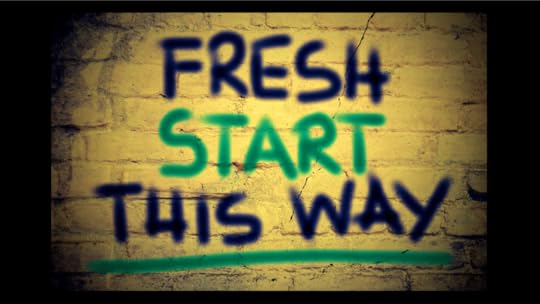
Estimated reading time: 5 minutes
(Editor’s Note: Today’s article is brought to you by our friends at Accurate Background , a leading provider of compliant background checks, drug and health screenings, and Form I-9 verifications. They’ve been named to . Congrats to them. Enjoy the read!)
With unemployment at record lows, organizations need to think about how to make their recruiting processes more inclusive. The recruiting function will not be successful if all it’s designed to do is screen people out. The process needs to be focused on creating good matches with candidates and knowledge, skills, and abilities (KSAs).
One effort that organizations should consider in their recruiting strategy is second chance or fair chance employment. This is the practice of hiring individuals with criminal histories.
Before we go any further, I think there’s some background information worth sharing. According to The Sentencing Project, between 70M and 100M – or approximately one in three Americans – have some sort of criminal record. Communities of color, LGBTQ+ individuals, and people with histories of abuse or mental abuse are disproportionately affected. The bottom-line is there’s a large group of people who have criminal records.
And having a criminal record doesn’t necessarily mean being incarcerated. Of the 70M people with a criminal record, only 10% have been incarcerated. The United States has one of the highest incarceration rates in the world (but we’ll save that conversation for another day).
I’m bringing up these statistics about criminal records and incarceration because we, as HR professionals, need to educate our organizations. There could be are people who think that everyone with a criminal history has gone to jail and that’s simply not true.
Organizations are looking for employees. And there are candidates – qualified candidates – out there. This is an opportunity to give a person who wants a job … a job. In addition, for organizations that are focused on diversity, equity, and inclusion (DEI), this is an opportunity to help individuals who have been disproportionately affected by giving them a job.
Now, I understand that some people might be thinking, “I’d love to do this, but our jobs and industry require that candidates be able to get a security badge, etc. This often impacts the eligibility of candidates with a criminal history.” Before you leave today’s article, hear me out.
I recently learned of an organization called the Second Chance Business Coalition. It’s an organization that promotes the benefits of second chance employment. Its members include financial institutions, airlines, software companies, manufacturing firms, retail, and more. So before completely dismissing the idea that “it can’t be done”, check out this organization. Especially the “find a partner” section of their website. It’s possible that it can be done.
Let’s move on to the reasons to consider second chance employment. In thinking about the research, there are four beneficiaries of second chance employment. And those beneficiaries are the reasons that organizations should consider.
ORGANIZATIONS: Since we’re business professionals, let’s first discuss the benefit to the organization and the bottom line. According to research from the Society for Human Resource Management (SHRM), 81% of HR professionals said that their cost per hire was about the same – or less – than workers without criminal records. So, it doesn’t cost more to give people second chances.
Plus employees are loyal to the organization. On the Kroger website, they talk about their New Beginnings program, which gives talented people second chances. They report a 93% retention rate with program participants. We all know turnover is expensive. Second chance programs can reduce cost per hire and increase retention.
CUSTOMERS: Don’t forget why we’re talking about hiring in the first place – the customer. In the same SHRM report, 85% of HR professionals believe that workers with criminal records perform their jobs at the same level or better than workers without. 75% said workers with criminal records are just as dependable. Giving people second chances doesn’t mean the organization isn’t hiring qualified people. We need to eliminate the bias that giving someone a second chance means the candidate is second rate.
CANDIDATES / EMPLOYEES: Second chance programs help people get jobs. It’s time to put the conversations about “people just don’t want to work anymore” in the rear-view mirror. People looking for a second chance want to work. They have skills. They want to move on with their life.
And business leaders want this as well. Jamie Dimon, chairman and chief executive of JPMorgan Chase & Company, penned an opinion article in The New York Times about the importance of supporting individuals who have “paid their debt to society”. It’s worth checking out.
COMMUNITY: When people with criminal histories can find work and stay employed, recidivism in the community is reduced. In the United States, almost 44% of individuals with a criminal conviction return to prison within their first year out. To understand the impact, the Council of State Governments (CSG) Justice Center is a national, nonpartisan, nonprofit organization that provides research to increase public safety and strengthen communities. They have a chart on their website that shows the cost of recidivism by state population. For example, Wisconsin ranked highest at $72 per resident.
Recidivism impacts everyone. And we have the resources to stop it.
Second chance employment allows people who want to work get a job. Companies get talented employees who are loyal to the company. Customers get excellent products and services because companies have enough staff. And communities can thrive. THIS is why second chance employment is important and why organizations should spend some time considering it.

In fact, if you want to learn more about second chance employment, including how to integrate it into your recruiting strategy, join me and the Accurate team on Wednesday, July 26 at 11a Pacific / 2p Eastern for a webinar on “Fair Chance Hiring for Your Workplace”. We’ll be doing a deeper dive into second chance employment – sharing more resources, talking implementation strategies, and how background screenings play a role in the process. I hope you can join us.
A growing number of organizations are developing second chance employment programs. Because it’s the right thing to do. And it makes good business sense. When you can do both, it kinda seems like a no-brainer that’s a win for all.
The post 4 Reasons for Organizations to Consider Second Chance Employment appeared first on hr bartender.
Sharlyn J. Lauby's Blog
- Sharlyn J. Lauby's profile
- 10 followers



